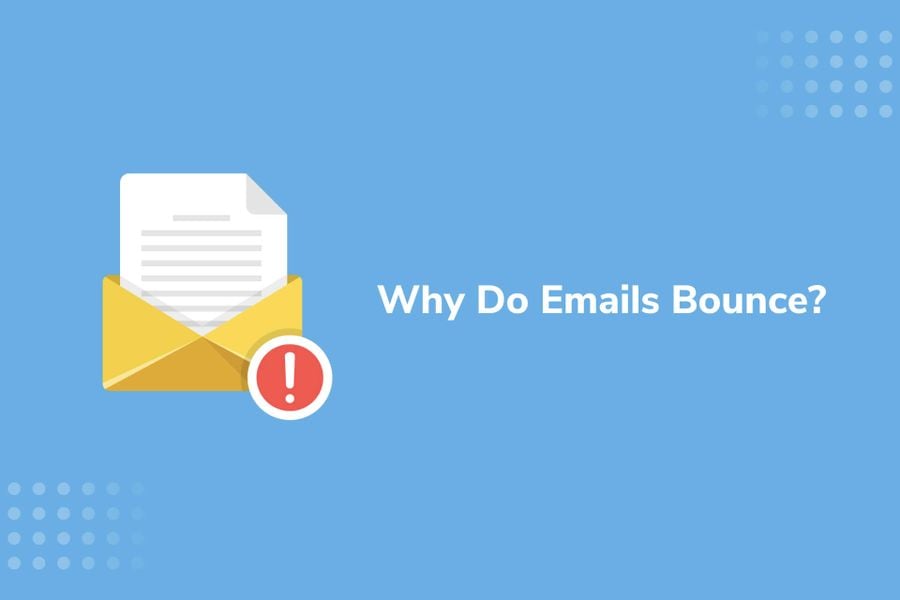Emails bounce when your marketing emails are rejected by a receiving mail server. Email bounces signal that something has happened to your message before it is able to be delivered and read by your recipients.
Email bounces can seem alarming if you don’t know why they’re occurring, so it’s important to understand how and why they happen so you can better assess and resolve the root issue.
While email bounces are definitely an inconvenience, there are ways to evaluate what’s going wrong and take steps to reverse an elevated bounce rate you may be seeing.
What's Ahead:
- Hard vs. Soft Email Bounces
- Reasons Why Emails Bounce
- How Bounce Rate Impacts Your Email Sender Reputation
- How to Reduce Email Bounce Rate
Why Should You Care About Bounced Emails?
ESP’s, or Email Service Providers, see high bounce rates as a red flag, as they can indicate that marketers are using unfavorable tactics, sending spammy content, or buying lists. If you maintain a trend of high bounce rates, ESP’s are more likely to banish your brand’s messages to the spam folder in the future, which stands in the way of you successfully communicating with genuinely engaged subscribers.
Hard and Soft Email Bounces
There are two primary types of email bounces— hard bounces and soft bounces.
A hard bounce occurs when an email is unable to be delivered due to a permanent issue, including an invalid or blocked email address. Hard bounces aren’t fixable, so you’ll want to remove these recipients from your list permanently. Some ESP’s will automatically suppress hard bounced recipients, so make sure to check with your provider to see how they deal with hard bounces.
In contrast to a hard bounce, a soft bounce occurs when an email goes undelivered due to a temporary issue. When your emails soft bounce, you generally have more options find a fix. Unlike a hard bounce, a soft bounce isn’t a sign you should completely give up on the recipient in question.
Reasons Emails Hard and Soft Bounce
Emails hard and soft bounce for a variety of reasons.
Some common reasons emails soft bounce include:
- The email is “undeliverable”— An undeliverable email can be the result of a temporary server outage or the server undergoing maintenance. If this issue persists, the server could be permanently gone.
- The recipient’s inbox is full— A soft bounce can also be a symptom that your recipient’s mailbox is too cluttered and can’t accept any more messages. This can also mean that your contact has stopped using this email address, so you may want to follow up with them via another channel to update their information in your system.
- The email fails to meet server requirements— Your message doesn’t meet the recipient server’s anti-spam, anti-virus, or DMARC authentication requirements.
- There's an issue with message size—Your email message is too big.
- You receive an autoreply — If your contact is gone on vacation or is otherwise out of the office, your emails to them will bounce.
Some common reasons emails hard bounce include:
- The email address doesn’t exist— This can happen due to a recipient misspelling their email, or leaving the affiliated organization.
- The email address is fake —this may happen if you’re offering something in exchange for a contact email.
- The email is blocked—This occurs when the receiving email server has rejected your email. Either your recipient intentionally blocked you, or their domain has stringent spam filter settings.
When your emails bounce, you’ll generally receive a delivery status notification. To understand why your emails are bouncing, you’ll want to keep bounce back emails to glean more information. You’ll want to record the date of the bounce, the bounce code, the bounce type, and the bounce description shown in your campaign reports.
Take a look at the SMTP, or Simple Mail Transfer Protocol error code number, to get some of this context. SMTP is a standard implemented by mail servers, and these error codes are designed to help you diagnose sending issues you may be experiencing. Mail providers will often include messages explaining these codes.
How Bounce Rate Impacts Your Email Sender Reputation
Email bounces directly impact your sender reputation. Your sender reputation, which relates to your deliverability, is a rating assigned to your IP address and domain.
Your bounce rate sits among the top factors that play into your sender reputation, alongside other signals such as your email volume, the number of spam complaints you receive, and whether or not you appear on email blacklists.
Your email bounce rate can be defined as the percentage of your emails that bounced.
When your email bounce rate is too elevated, your ESP will begin penalizing your sender reputation. So what is the cutoff here?
Generally speaking, you should keep your bounce rates under two or three percent. When your bounce rates rise to five percent and above, you’re entering the danger zone. This is when your ESP may start to take note and begin penalizing your sender reputation.
How to Reduce Email Bounce Rate
Lower bounce rates translate to a better sender score and better health for your email campaigns. So what actionable steps can you take to keep your bounce rates in check?
1. Monitor Your Hard and Soft Bounces
Generally, your email provider will give you insight into your distinct hard and soft bounce rates. Understanding the split between your hard and soft bounces can help you better pinpoint the issue you’re facing.
For example, you shouldn't usually see abrupt increase in hard bounces, unless you’re sending to an unverified list.
2. Deploy a Double Opt-In
Think about your ideal recipient—someone who’s enthusiastic and interested in receiving your email communications. To ensure that your list is made up of the highest quality contacts, use a double opt-in. To do so, after email recipients subscribe to your list, send them a confirmation email prompting them to appropriately verify their address. This process will weed out recipients who subscribed by accident and ensure that recipients who genuinely want to receive your emails aren’t making typos in the subscription process. It will also eliminate emails that are invalid.
3. Don't Buy Email Lists
In the world of email marketing, it can seem tempting to buy or borrow subscribers. You might think it’s worth buying a list to get more recipients’ eyes on your messages. Unfortunately, buying email lists is a dangerous tactic that can have serious downstream consequences, including leading to higher bounce rates.
First and foremost, buying emails violates the terms of the GDPR, which requires your recipients’ explicit consent in order to send marketing emails. Explicit consent involves a recipient directly taking an action to indicate they want to be on your email list, like checking a box. Violating the GDPR can be serious, incurring steep fines for your brand. Short of suffering legal trouble as a result of buying a list, bought subscribers are more likely to block you as a sender, which will lead to a higher bounce rate.
4. Clean and Verify Your Email Lists
One of the best ways to combat an increase in soft bounces is by getting into the practice of regular list cleaning. Understanding where your contacts came from and making sure they’re engaged will keep your bounce rates in check. To clean your list, you’ll remove inactive subscribers and those who haven’t engaged in a certain amount of time. It’s also considered a best practice to remove hard bounces after each email campaign.
Sometimes, manual list cleaning isn’t practical, but your email provider may give you a way to automatically segregate and suppress hard-bounced subscribers.
Similar to cleaning your list, verifying your recipients’ addresses involves removing emails with invalid domains, that are duplicates, or that are inactive. Shorter verified lists are always better than longer, unverified lists.
5. Improve Your Email Deliverability
If you notice your emails have high bounce rates, you could be overlooking a more significant email deliverability issue. Maintaining good sending practices overall will help increase the deliverability of your campaigns, which will in turn reverse the issue of soft bounces.
Make sure you’re considering the other signals that affect your overall deliverability, including maintaining your sender reputation, maximizing engagement, and managing email volume.
Choosing the Right Email Provider
In choosing the right email provider, you'll want a solution that helps you effectively capture your users' emails, manage your list, and send strategic campaigns. The best solutions will help you maximize deliverability with easy authentication capabilities, sophisticated reporting, and robust customer resources.
With OneSignal, you can send dynamic email campaigns and manage all of your cross-channel communication from one intuitive platform. We partner with best-in-class email providers SendGrid, Mailgun, and Mailchimp. Try us out for free today!
Create a Free Account



